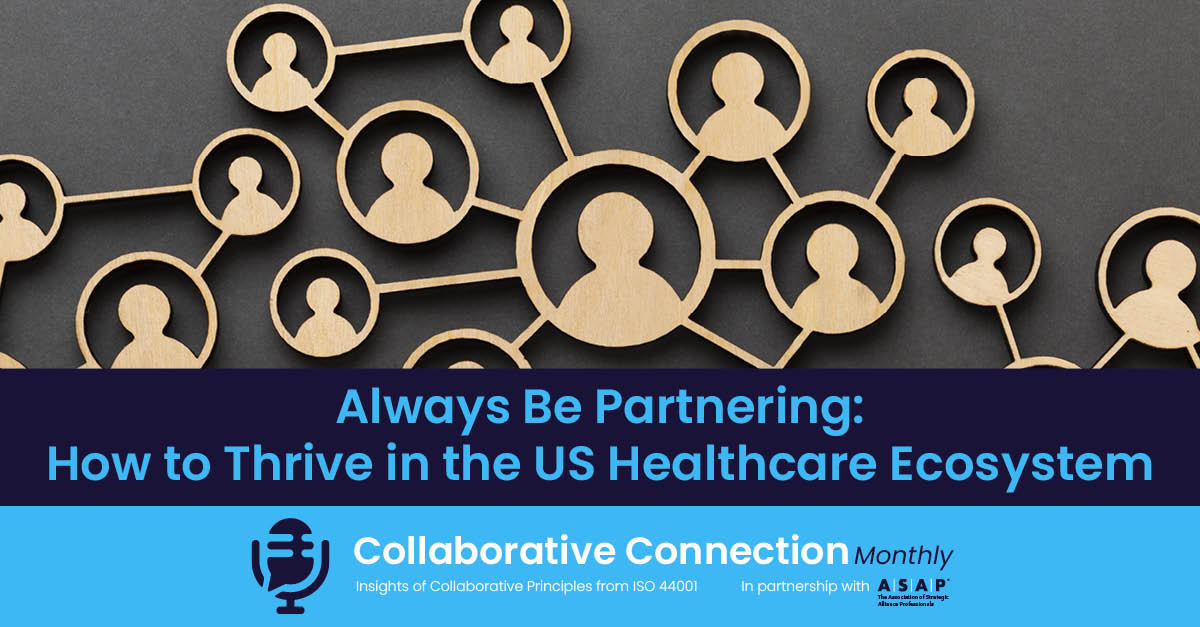Always Be Partnering: How to Thrive in the US Healthcare Ecosystem
The ever-expanding and ever-complicated US healthcare ecosystem is a challenging landscape to navigate. There are so many players from the public and private sector—hospitals, device companies, data and analytics startups, physicians, patient advocacy groups, professional societies, Congress, and the Food and Drug Administration (FDA), to name a few—and many of them have competing priorities. It’s a long and winding road with many obstacles, creating a high barrier to entry for startups like Eysz, which leverages oculometric data from consumer-grade eye-tracking systems in a way that helps treat patients with various neurological disorders, such as epilepsy.
Eysz cofounder Parth Amin gave attendees of the May Collaborative Connection Monthly webinar and roundtable, “Delivering Value in an Ecosystem of Co-opetition and Misaligned Objectives,” a glimpse of this bumpy healthcare business and regulatory environment. But the news isn’t all bad; Amin also gave some tips—and some hope—for achieving great patient outcomes through successful collaboration.
Law and Disorder
Amin noted a few major conflicts between these players, many of which have no choice but to work together (the FDA and Congress aren’t going anywhere, for example). The others—pharmaceutical companies, insurers, physician practices, and hospitals—are oftentimes inherently in each other’s way.
“Partners talk as if they’re aligned on objectives,” Amin explained, but in reality, “rather than being aligned on the patient, they’re more aligned on the financials.”
“In the healthcare system, patients are viewed as either revenue or costs,” Amin continued. When patients pay doctors or hospitals for a procedure, insurance companies are often on the hook to reimburse them. “That revenue for the hospital came out as a cost to the insurer. That’s one significant conflict in how they view the patient—you have this misalignment right there.”
Amin listed other examples of disparities in objectives between players in the healthcare ecosystem:
- A gene therapy company’s treatment for a rare blood disorder costs $1.8 million, but German health authorities would only agree to cover one-third of the total. The pharmaceutical company declined to commercialize it in Germany because the $1.2 million gap would take too big a chunk out of its margins. “They couldn’t collaborate and focus on the patient,” noted Amin.
- Even when doctors know a particular drug or treatment with a higher price tag will work, insurance companies will insist that they try the lower-cost options first before getting to the desired therapy. It may take months or years to go through the other drug courses, which could produce side effects and ultimately prolong the disease.
- Doctors complain that too much of their time is spent on documentation and administration pertaining to electronic health records (EHRs). In addition, the EHR companies are making it harder for patients to switch doctors by putting up roadblocks to data sharing. They’re being more protective of their IP in part because traditional tech-industry players are now seeking to build services on the same EHR patient data. “EHR companies know that data is king. Some of them don’t want to unlock the data for some of the tech companies,” said Amin.
- For startups like Eysz to get market traction, it would help if insurance companies would reimburse for its technology. However, insurers won’t agree to do so until the FDA approves these small companies’ offerings, and the manufacturers garner some early customer momentum. The problem: it takes five years to develop these types of technologies and another five to successfully commercialize them. Startups generally fail in half that time or less. Unfortunately, even when you tell doctors your product can save lives, ask them to use it without reimbursement and “the answer is flat-out, ‘No!’” said Amin.
Where There’s a Will—and a Partner—There’s a Way
Fortunately, where there’s a will—and partnering skill—there’s a way. Amin said that even within these resisting companies and regulatory bodies, there are people who see the light.
“Within every partner entity you just have to find the right champion,” he said. A clinician within a hospital or practice group may push for insurance companies to pay for a treatment or pay for the product out of pocket if they see the value for the patient. Also, there are other sources of cash aside from insurance companies. The National Institutes of Health (NIH) and the National Science Foundation (NSF) are some of the US’s biggest funders of startups. Larger pharmaceutical and medical device companies, too, might provide money or lobbying resources if their interests are aligned with a startup.
“It just comes down to collaborating with people within the ecosystem that share your values and objectives, even though the overall ecosystem is misaligned,” said Amin.
The trick is to determine the right timing—when the value proposition of an offering reaches a stage where it meshes with other ecosystem players.
“In this large ecosystem, you’re going to need to decide how and when you want to engage the partners. You may not need to engage all of them at once. You may not want to be openly collaborative right off the bat.”
The New ABC
In a twist on the old phrase “Always be closing,” Amin said the secret is to “always be partnering! It’s the only way you’re going to successfully navigate this ecosystem.”
“It’s the new ABC—always be collaborative,” quipped moderator Leona Kral, CSAP, chief connections officer at Mycelia Solutions.

